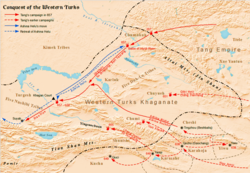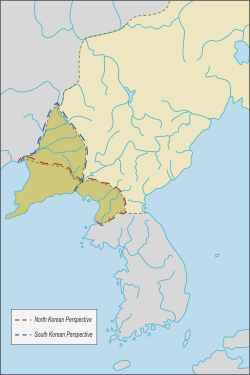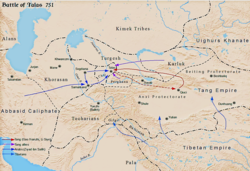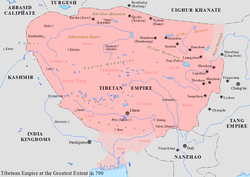| Year | Date | Event |
|---|
| 750 | | Tang defeats the Turgesh-Chach and executes the king of Chach |
| Chinese cultural dominance in Liaoning disappears and is replaced by Khitan culture |
| 751 | | Battle of Talas : Tang forces are defeated by Arabs |
| Xianyu Zhongtong attacks Nanzhao with an army of 80,000 but is utterly defeated, losing three quarters of his original force |
| 752 | | An Lushan attacks the Khitans |
| 753 | | Geshu Han ejects the Tibetans from the "Nine Bends" region on the upper course of the Yellow River |
| 754 | | Yang Guozhong invades Nanzhao but fails to engage with the enemy until supplies ran out, at which time they were attacked and routed |
| Monk Jianzhen arrives in Japan and establishes the Risshū (Buddhism) sect in Nara |
| 755 | | An Lushan Rebellion : An Lushan rebels and declares himself emperor of Yan |
| 756 | spring | Battle of Yongqiu : Yan forces retreat from their siege of a Tang fortress |
| 12 August | Emperor Xuanzong of Tang flees Chang'an. On his way to Sichuan, he is forced to order the death of his favorite consort Yang Guifei and abdicates in favor of Emperor Suzong of Tang |
| The Taoist Mao Kua reports in his Pinglongren (Recognition of the Recumbent Dragon) that by heating saltpeter, the yin of the air can be obtained, which combines with sulphur, carbon, and metals other than gold. |
| 757 | | An Lushan is killed by his son An Qingxu |
| Battle of Suiyang : Yan forces emerge victorious with great losses |
| Tang counterattack under Guo Ziyi and Uyghur allies evict the Yan from Chang'an and Luoyang |
| An Qingxu flees across the Yellow River to southern Hebei |
| Tibetan Empire conquers Shan Prefecture |
| 758 | | Princess Ningguo, second daughter of Emperor Suzong of Tang, marries Bayanchur Khan of the Uyghur Khaganate |
| 759 | | An Qingxu is killed by rebel Shi Siming |
| Shi Siming occupies Luoyang |
| Jianzhen founds the Tōshōdai-ji in Nara, Japan |























